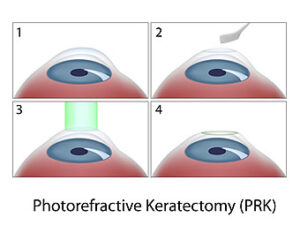Posted by: Manhattan LASIK Center
Are you considering an alternative to visual aids like glasses and contact lenses? A vision correction procedure has probably already crossed your mind as an option if this is the case.
You’ve almost certainly heard of the most popular vision correction procedure, LASIK. But it isn’t the only vision correction procedure available.
As popular as LASIK is, not everyone will qualify for it. Some patients may have corneas that are too thin or existing eye conditions like dry eye syndrome that make LASIK unsafe.
If this is the case, the good news is that there are other vision correction options for patients who aren’t good LASIK candidates. One of these options is PRK.
PRK is a procedure that is very similar to LASIK, though it does have some distinct differences. But what makes PRK different from LASIK?
How does it work? How do you know if it’s right for you? Keep reading to learn what PRK is and if it could be the right vision correction procedure for you!
What is PRK?

PRK stands for Photorefractive Keratectomy. It’s a refractive laser eye procedure that changes how light refracts through your eyes.
Refractive errors, like nearsightedness, farsightedness, and astigmatism, occur when the cornea is an irregular shape. The cornea is the transparent front part of the eye.
It’s also what light passes through before it hits the retina, which lines the back of your eye. Light needs to hit the retina at its focal point to correctly project what you’re looking at to your brain.
The cornea must bend or refract that light. But when the cornea is an irregular shape, the light won’t refract as it should.
Instead, the light hits its focal point in front of or behind the retina. This causes blurry vision at certain distances when you have a refractive error.
Refractive laser vision correction procedures use lasers to change the shape of the cornea to correct refractive errors. PRK does this by first removing the cornea’s outermost layer, called the epithelium, with a chemical scrub.
Then a specialized laser called an excimer laser is programmed to remove tiny, specific sections of corneal tissue to correct the eye’s overall shape. Afterward, bandage contact lenses are applied to the eyes to protect them while the epithelium grows back, a process which typically takes two weeks.
PRK vs. LASIK

Although LASIK is the most well-known laser vision correction procedure, PRK predates it. It was the first laser vision correction procedure ever designed.
Since its inception, the technology used to perform the procedure has advanced, as has medical knowledge. PRK uses up-to-date technology and achieves virtually identical results as LASIK.
It is a safe and effective procedure that can completely correct nearsightedness, farsightedness, and astigmatism.
Although LASIK and PRK share some similarities, there is a critical difference between them. During LASIK, instead of removing the epithelium before using the excimer laser, a flap is made in the cornea.
The flap is created with another laser called a femtosecond laser that separates the topmost part of the cornea. It leaves a small hinge to lift the flap.
After using the excimer laser, the flap is then replaced, where it acts as a natural bandage that protects the eye as it heals. The corneal flap allows a more straightforward healing process and helps patients see immediate visual improvement after LASIK.
PRK patients take longer before they start seeing visual improvements. They have to wait until the eye begins to heal to experience the effects of the procedure.
LASIK’s faster recovery and almost instant results are part of what makes it so appealing to so many people. However, PRK may be better for some patients because it doesn’t require a corneal flap.
Why Should You Choose PRK?

LASIK is a good option for many patients looking to correct their vision. But your cornea needs to be thick enough to create a corneal flap to have LASIK.
If your cornea is too thin, getting LASIK can have serious consequences for your vision. Most people have thick enough corneas to allow for a flap, but some patients have thinner corneas than others.
Having thinner corneas doesn’t necessarily indicate any health problems, but it does disqualify you from having LASIK. Since PRK doesn’t require creating any corneal flap, patients who otherwise would qualify for laser vision correction procedures but have thin corneas can safely have PRK.
You probably don’t know how thick your corneas are, but they’re measured when you’re evaluated for vision correction surgery. We offer comprehensive vision assessments at Manhattan LASIK Center in Manhattan.
If you have a LASIK consultation only to find your corneas are too thin, you may still be able to have PRK. If you want visual freedom from contact lenses and glasses but don’t qualify for LASIK due to thin corneas, PRK may be a great choice. PRK can correct your vision and eliminate the need for contacts or glasses just as well as LASIK.
Long-Term Outcomes

Despite being the more popular surgery, LASIK outcomes are comparable to PRK outcomes. While the initial healing process for LASIK is considered easier thanks to the corneal flap, the actual full healing time for both procedures is the same. It takes between 3-6 months to heal after LASIK and PRK.
PRK and LASIK patients also have a high success rate, with over 95% of patients achieving 20/20 vision or better. Like LASIK, PRK is also permanent.
Neither procedure prevents your eyesight from worsening due to common age-related eye conditions. As long as you’re under 40 and your prescription is stable when you have the procedure, there’s an excellent chance you’ll have incredible vision for years and years to come.
Make an appointment today at Manhattan LASIK Center in Westchester, NY, for a commitment-free complimentary consultation to determine what vision correction procedure is right for you.

